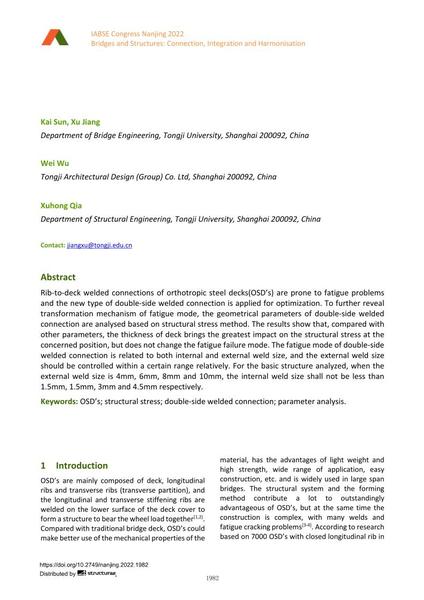Parameter Analysis on Double-side Welded Connection of Orthotropic Steel Decks Based on Structural Stress

|
|
|||||||||||
Bibliografische Angaben
| Autor(en): |
Kai Sun
(Department of Bridge Engineering, Tongji University, Shanghai 200092, China)
Xu Jiang (Department of Bridge Engineering, Tongji University, Shanghai 200092, China) Wei Wu (Tongji Architectural Design (Group) Co. Ltd, Shanghai 200092, China) Xuhong Qia (Department of Structural Engineering, Tongji University, Shanghai 200092, China) |
||||
|---|---|---|---|---|---|
| Medium: | Tagungsbeitrag | ||||
| Sprache(n): | Englisch | ||||
| Tagung: | IABSE Congress: Bridges and Structures: Connection, Integration and Harmonisation, Nanjing, People's Republic of China, 21-23 September 2022 | ||||
| Veröffentlicht in: | IABSE Congress Nanjing 2022 | ||||
|
|||||
| Seite(n): | 1982-1990 | ||||
| Anzahl der Seiten (im PDF): | 9 | ||||
| DOI: | 10.2749/nanjing.2022.1982 | ||||
| Abstrakt: |
Rib-to-deck welded connections of orthotropic steel decks(OSD’s) are prone to fatigue problems and the new type of double-side welded connection is applied for optimization. To further reveal transformation mechanism of fatigue mode, the geometrical parameters of double-side welded connection are analysed based on structural stress method. The results show that, compared with other parameters, the thickness of deck brings the greatest impact on the structural stress at the concerned position, but does not change the fatigue failure mode. The fatigue mode of double-side welded connection is related to both internal and external weld size, and the external weld size should be controlled within a certain range relatively. For the basic structure analyzed, when the external weld size is 4mm, 6mm, 8mm and 10mm, the internal weld size shall not be less than 1.5mm, 1.5mm, 3mm and 4.5mm respectively. |
||||
| Stichwörter: |
Parameteranalyse
|
||||
| Copyright: | © 2022 International Association for Bridge and Structural Engineering (IABSE) | ||||
| Lizenz: | Die Urheberrechte (Copyright) für dieses Werk sind rechtlich geschützt. Es darf nicht ohne die Zustimmung des Autors/der Autorin oder Rechteinhabers/-in weiter benutzt werden. |
||||
